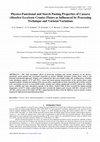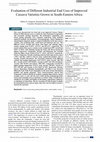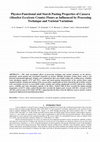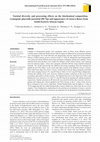Papers by Cornelius Nkonkola

Asian Journal of Agriculture and Food Sciences
This study investigated effects of processing technique and varietal variations on the physico-fu... more This study investigated effects of processing technique and varietal variations on the physico-functional, starch pasting and viscoelastic properties of cassava (Manihot Esculenta Crantz) flours using a 3x6 factorial experimental approach. Samples were evaluated for their non-volatile acidity, pH, swelling power, solubility water absorption capacity (27oC and 70oC), colour and starch pasting characteristics of the cassava flours using standard methods. Grating and soaking of the cassava tubers significantly (p<0.05) reduced the pH of all the varieties with concomitant increases in non-volatile acidity. Grating and soaking significantly (p<0.05) reduced the swelling power, solubility and water absorption capacity of the flours. Soaked Chila B flour recorded the highest pasting temperature of 66.9°C whiles soaked Mweulu flour recorded the highest peak viscosity (684 BU), viscosity at 95oC (683 BU) and viscosity at 95oC-hold (359 BU), suggesting that the flours from the different...

European Journal of Agriculture and Food Sciences
This work characterized two local and seven improved Cassava Mosaic Disease [CMD]-tolerant cassav... more This work characterized two local and seven improved Cassava Mosaic Disease [CMD]-tolerant cassava varieties for their biochemical composition and viscoelastic (pasting) properties. The biochemical composition and starch pasting properties were evaluated respectively using standard analytical methods and Brabender Viscoamylograph. Cluster dendogram and principal component analyses compared similarities in the nine cassava varieties, thus predicting their varied food and industrial end uses. The different cassava varieties had starch, total sugars and reducing sugars content ranging from 53-69%, 6.5-9.2% and 0.9-2.5%, respectively. The starch content of the cassava varieties on dry weight basis (DW) varied from 54.0% to 69.0% with Nalumino having the lowest and Mweru having the highest respectively. Tanganyika, Mweulu, and Banguerlu also recorded relatively higher starch content of 62.7%, 63.6% and 63.6% respectively. Mweru, Tangayoka, Mweulu, and Bangweulu had fairly high starch con...

European Journal of Agriculture and Food Sciences, 2022
This work characterized two local and seven improved Cassava Mosaic Disease [CMD]-tolerant cassav... more This work characterized two local and seven improved Cassava Mosaic Disease [CMD]-tolerant cassava varieties for their biochemical composition and viscoelastic (pasting) properties. The biochemical composition and starch pasting properties were evaluated respectively using standard analytical methods and Brabender Viscoamylograph. Cluster dendogram and principal component analyses compared similarities in the nine cassava varieties, thus predicting their varied food and industrial end uses. The different cassava varieties had starch, total sugars and reducing sugars content ranging from 53-69%, 6.5-9.2% and 0.9-2.5%, respectively. The starch content of the cassava varieties on dry weight basis (DW) varied from 54.0% to 69.0% with Nalumino having the lowest and Mweru having the highest respectively. Tanganyika, Mweulu, and Banguerlu also recorded relatively higher starch content of 62.7%, 63.6% and 63.6% respectively. Mweru, Tangayoka, Mweulu, and Bangweulu had fairly high starch content (>60%) and thus could be used for many commercial products such as starches, alcohols and glucose. The viscoelastic properties of the different varieties had pasting temperature (63.5-67.6 o C), peak viscosity (402-595 BU), viscosity at 95 o C (394-592 BU), viscosity at 50 o C (126-254), breakdown viscosity (236-352 BU) and setback (-100-4 BU). Tanganyika recorded the highest pasting temperature (67.6 o C), peak viscosity (595 BU), viscosity at 95 o C (592 BU) and viscosity at 95 o C-hold (317 BU). Bangweulu, Mweulu, Mweru, Manyokola, Nalumino, Kampolombo and Chila A were clustered differently from Chila B and Tanganyika on the basis of their biochemical qualities and pasting properties. These characterizations showed that Tanganyika would be suitable for products requiring high elasticity and gel strength, easier to cook and also more stable during cooking/preparation such as fufu (pounded cassava) and banku or Nshima. Chila A would also be suitable for use as fillers and binders in the baking, confectionery industries as substitutes of wheat flour. The low viscosities of Chila B make it suitable for household food uses such as snacks where the roots are boiled, roasted or toasted and consumed.

Asian Journal of Agriculture and Food Sciences , 2021
This study investigated effects of processing technique and varietal variations on the physicofun... more This study investigated effects of processing technique and varietal variations on the physicofunctional, starch pasting and viscoelastic properties of cassava (Manihot Esculenta Crantz) flours using a 3x6 factorial experimental approach. Samples were evaluated for their non-volatile acidity, pH, swelling power, solubility water absorption capacity (27 o C and 70 o C), colour and starch pasting characteristics of the cassava flours using standard methods. Grating and soaking of the cassava tubers significantly (p<0.05) reduced the pH of all the varieties with concomitant increases in non-volatile acidity. Grating and soaking significantly (p<0.05) reduced the swelling power, solubility and water absorption capacity of the flours. Soaked Chila B flour recorded the highest pasting temperature of 66.9°C whiles soaked Mweulu flour recorded the highest peak viscosity (684 BU), viscosity at 95 o C (683 BU) and viscosity at 95 o C-hold (359 BU), suggesting that the flours from the different cassava varieties could be targeted for different food and industrial products.

Changes in biochemical quality and cyanogenic safety in flours from different cassava varieties g... more Changes in biochemical quality and cyanogenic safety in flours from different cassava varieties grown within the Southeastern African region as influenced by processing technique were investigated. Two local (Mweulu and Tanganyika) and four improved Cassava Mosaic Disease (CMD)-tolerant cassava varieties (Chila A, Chila B, Bangweulu and Kampolombo) were processed using different processing techniques (chipping, grating and soaking). Flours obtained from these products were studied for changes in their starch content, total, reducing and non-reducing sugars, colour and cyanogenic potential (HCNp) using standard analytical methods. The results showed that the different processing techniques had only minimal but significant (p<0.05) effects on the starch and sugar content of the different cassava varieties. Flour made from chips from all six cassava varieties had relatively high cyanogenic potentials with values ranging between 30.1 mg HCN/kg in Chila A to 64.3 mg HCN/kg in Bangweulu. Grating and soaking of the roots, however resulted in drastic reductions in the levels of the cyanogenic glucosides in all the varieties. The high HCNp levels in the chips from Chila A and Bangweulu were reduced to 16.2 and 13.5 mg HCN/kg by the grating and soaking treatments respectively. Similar reductions in HCNp levels were noted for all the other varieties. Likewise, grating and soaking also caused significant (p<0.05) increase in the L *-values of the cassava flours compared to the cassava chip flours. Soaked Kampolombo had the highest L *-value of 78.40 suggesting that the soaked Kampolombo cassava sample was whiter than the rest of the samples. These findings have implications for the preference and adoption of cassava varieties where the colour of the flour is deemed to be important for the preparation of preferred dishes.
Food Research International

Changes in biochemical quality and cyanogenic safety in flours from different cassava varieties g... more Changes in biochemical quality and cyanogenic safety in flours from different cassava varieties grown within the Southeastern African region as influenced by processing technique were investigated. Two local (Mweulu and Tanganyika) and four improved Cassava Mosaic Disease (CMD)-tolerant cassava varieties (Chila A, Chila B, Bangweulu and Kampolombo) were processed using different processing techniques (chipping, grating and soaking). Flours obtained from these products were studied for changes in their starch content, total, reducing and non-reducing sugars, colour and cyanogenic potential (HCNp) using standard analytical methods. The results showed that the different processing techniques had only minimal but significant (p<0.05) effects on the starch and sugar content of the different cassava varieties. Flour made from chips from all six cassava varieties had relatively high cyanogenic potentials with values ranging between 30.1 mg HCN/kg in Chila A to 64.3 mg HCN/kg in Bangweulu. Grating and soaking of the roots, however resulted in drastic reductions in the levels of the cyanogenic glucosides in all the varieties. The high HCNp levels in the chips from Chila A and Bangweulu were reduced to 16.2 and 13.5 mg HCN/kg by the grating and soaking treatments respectively. Similar reductions in HCNp levels were noted for all the other varieties. Likewise, grating and soaking also caused significant (p<0.05) increase in the L *-values of the cassava flours compared to the cassava chip flours. Soaked Kampolombo had the highest L *-value of 78.40 suggesting that the soaked Kampolombo cassava sample was whiter than the rest of the samples. These findings have implications for the preference and adoption of cassava varieties where the colour of the flour is deemed to be important for the preparation of preferred dishes.





Uploads
Papers by Cornelius Nkonkola